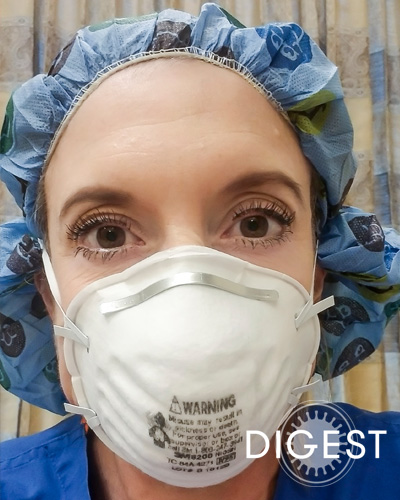Casey Naughton Dowling, DO ’89, FASA
PCOM Heroes of the Frontline
Anesthesiologist, Winchester, Virginia
“We’re nestled in the Shenandoah Valley and apparently were somewhat protected from
COVID at first. We have been learning ever since it hit New York. The information
has been a tsunami daily, and yet we still just don’t know what’s going to happen.
And that is so unbelievably stressful. … I get emails from the American Society of
Anesthesiologists, from the CDC, from the FDA. … There is no literature on this, so
it’s been a collaboration of physicians: ‘How did you take care of these patients?
How did you cover for lack of PPE?’. … Our hospital was very proactive in turning
to us to say, ‘Look, if we get a big surge, you’re going to be our go-to people to
help us cover that ICU.’ It makes perfect sense. Anesthesiologists are the experts
on intubation and extubation. If you’re looking to have the least amount of aerosolization,
you want the most practiced, the most experienced person doing that. We’re also the
intensivists of the ORs; we take care of everybody’s diabetes, high blood pressure.
We hang pressors, we do lines, we do transfusions, we do codes, we do all of that.
Osteopathically speaking, we take care of the whole person—that’s what anesthesiologists
do. … Fifteen to 20 of us have volunteered to cover intensive care. We went up, four
at a time, for a two-hour orientation. And then we’ve been going two at a time every
day to orient, do rounds and try to write a note. Again, stressful. It was like being
an intern again. … I can’t say enough about the people that were already taking care
of those respiratory patients in the unit, their grace under fire. And I can’t get
over my people, the anesthesiologists who have come up with so many different ways
to tent, to intubate and extubate and cover themselves. … Back when there was not
as much testing, I took care of the very first person under investigation that needed
to go to the operating room. Most operating rooms are the wrong pressure. They are
what’s called positive pressure: You want the infection to stay away from the patient,
so you’re blowing it all down and away. But with a patient who’s infected, you’d be
blowing it all over the room and giving it to everybody else. It becomes very involved.
… We literally created our policy of how to handle it that day, a Saturday. My chairman
came in, the safety officer came in—it took a village.”
As told to Janice Fisher
April 24, 2020
About Digest Magazine
Digest, the magazine for alumni and friends of Philadelphia College of Osteopathic Medicine,
is published by the Office of Marketing and Communications. The magazine reports on
osteopathic and other professional trends of interest to alumni of the College’s Doctor of Osteopathic Medicine (DO) and graduate programs at PCOM, PCOM Georgia and PCOM South Georgia.

 “We’re nestled in the Shenandoah Valley and apparently were somewhat protected from
COVID at first. We have been learning ever since it hit New York. The information
has been a tsunami daily, and yet we still just don’t know what’s going to happen.
And that is so unbelievably stressful. … I get emails from the American Society of
Anesthesiologists, from the CDC, from the FDA. … There is no literature on this, so
it’s been a collaboration of physicians: ‘How did you take care of these patients?
How did you cover for lack of PPE?’. … Our hospital was very proactive in turning
to us to say, ‘Look, if we get a big surge, you’re going to be our go-to people to
help us cover that ICU.’ It makes perfect sense. Anesthesiologists are the experts
on intubation and extubation. If you’re looking to have the least amount of aerosolization,
you want the most practiced, the most experienced person doing that. We’re also the
intensivists of the ORs; we take care of everybody’s diabetes, high blood pressure.
We hang pressors, we do lines, we do transfusions, we do codes, we do all of that.
Osteopathically speaking, we take care of the whole person—that’s what anesthesiologists
do. … Fifteen to 20 of us have volunteered to cover intensive care. We went up, four
at a time, for a two-hour orientation. And then we’ve been going two at a time every
day to orient, do rounds and try to write a note. Again, stressful. It was like being
an intern again. … I can’t say enough about the people that were already taking care
of those respiratory patients in the unit, their grace under fire. And I can’t get
over my people, the anesthesiologists who have come up with so many different ways
to tent, to intubate and extubate and cover themselves. … Back when there was not
as much testing, I took care of the very first person under investigation that needed
to go to the operating room. Most operating rooms are the wrong pressure. They are
what’s called positive pressure: You want the infection to stay away from the patient,
so you’re blowing it all down and away. But with a patient who’s infected, you’d be
blowing it all over the room and giving it to everybody else. It becomes very involved.
… We literally created our policy of how to handle it that day, a Saturday. My chairman
came in, the safety officer came in—it took a village.”
“We’re nestled in the Shenandoah Valley and apparently were somewhat protected from
COVID at first. We have been learning ever since it hit New York. The information
has been a tsunami daily, and yet we still just don’t know what’s going to happen.
And that is so unbelievably stressful. … I get emails from the American Society of
Anesthesiologists, from the CDC, from the FDA. … There is no literature on this, so
it’s been a collaboration of physicians: ‘How did you take care of these patients?
How did you cover for lack of PPE?’. … Our hospital was very proactive in turning
to us to say, ‘Look, if we get a big surge, you’re going to be our go-to people to
help us cover that ICU.’ It makes perfect sense. Anesthesiologists are the experts
on intubation and extubation. If you’re looking to have the least amount of aerosolization,
you want the most practiced, the most experienced person doing that. We’re also the
intensivists of the ORs; we take care of everybody’s diabetes, high blood pressure.
We hang pressors, we do lines, we do transfusions, we do codes, we do all of that.
Osteopathically speaking, we take care of the whole person—that’s what anesthesiologists
do. … Fifteen to 20 of us have volunteered to cover intensive care. We went up, four
at a time, for a two-hour orientation. And then we’ve been going two at a time every
day to orient, do rounds and try to write a note. Again, stressful. It was like being
an intern again. … I can’t say enough about the people that were already taking care
of those respiratory patients in the unit, their grace under fire. And I can’t get
over my people, the anesthesiologists who have come up with so many different ways
to tent, to intubate and extubate and cover themselves. … Back when there was not
as much testing, I took care of the very first person under investigation that needed
to go to the operating room. Most operating rooms are the wrong pressure. They are
what’s called positive pressure: You want the infection to stay away from the patient,
so you’re blowing it all down and away. But with a patient who’s infected, you’d be
blowing it all over the room and giving it to everybody else. It becomes very involved.
… We literally created our policy of how to handle it that day, a Saturday. My chairman
came in, the safety officer came in—it took a village.”